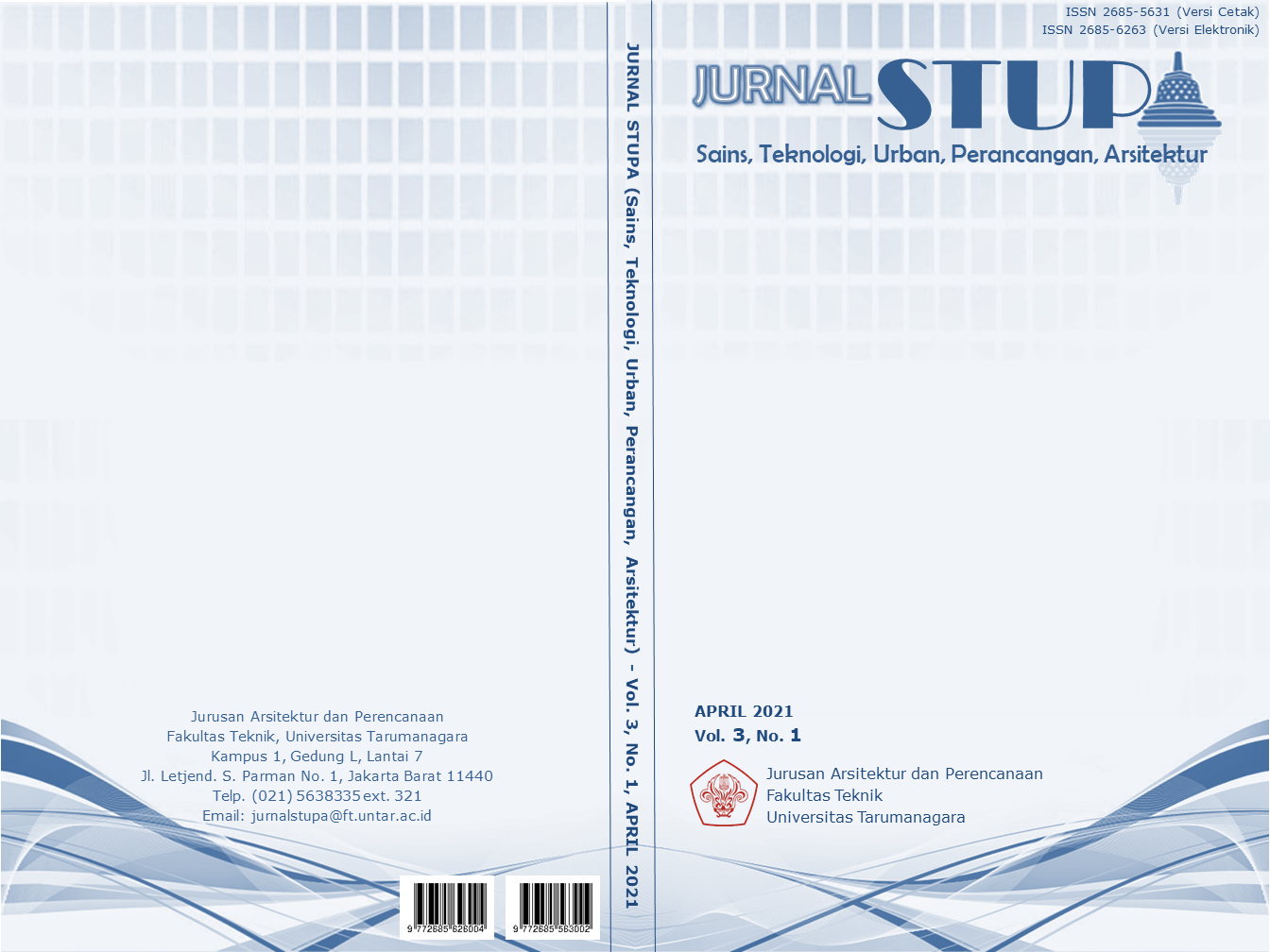METODE TRANSPROGRAMMING DALAM PERANCANGAN RUANG BERHUNI TERPADU KOMUNITAS UKM ROTAN DI GROGOL
Main Article Content
Abstract
The Covid-19 pandemic has impacted on any sectors, economic is one of the worst affected sector. In 2020, Indonesia’s economic growth in third quarter (Q3/2020), shrink by 3,49%. The economic deterioration is not only impact the big companies but also impacted on small business communities, such as the UKM (Usaha Kecil dan Menengah) that contribute the revenue of local government. One of much UKM that affected by the pandemic is UKM Rotan Semeru community, the central of UKM rattan in Jakarta Barat. The problem is not only the lower-income individuals or their concern about physical interactions but how the communities could survive and evolve in an unexpected situation. The competition between UKM with start-up and e-commerce on the realm of technology, internet, online media is a concern to form the future dwelling space for UKM community, especially UKM Rotan Semeru. The purpose of this study is to produce an integrated dwelling’s concept that could provide a place for live, producing, product’s develop, and marketing. Remember the program complexity integrates dwelling with creative process and technology based economic space, so trans-programming method was used to combining the locality and technology aspect. The result of design not only for commercial or working space but also residence. There are material’s element, manual production room, neighbors, and social activities to maintain the locality aspect. And then the technology on building shows up by the modern commercial spaces, windows shopping, drive-thru, and online shopping. The conclusion is the aspects and programs combination from the integrated dwelling of UKM Rotan’s design formed a future dwelling that bring a prosperity to their community.
Keywords: The Covid-19; locality; dwelling; UKM Rotan
Abstrak
Pandemi Covid-19 berdampak terhadap berbagai sektor, salah satunya sektor ekonomi. Sektor perekonomian di Indonesia mengalami kontraksi pertumbuhan ekonomi kuartal III/2020, sebesar 3,49 persen. Kemerosotan ekonomi tersebut tidak hanya berdampak pada kegiatan perusahaan-perusahaan besar, namun juga sangat berdampak bagi para pelaku usaha kecil, seperti komunitas penggiat Usaha Kecil dan Menengah (UKM) yang turut andil dalam perekonomian daerah. Satu dari sekian banyak komunitas UKM yang terdampak pandemi Covid-19 yaitu komunitas UKM Rotan Semeru-Grogol, yang merupakan sentra UKM pengrajin rotan di Jakarta Barat. Permasalahan yang terjadi bukan hanya penurunan pemasukan maupun kekhawatiran pembeli melakukan transaksi fisik, namun bagaimana agar komunitas tetap dapat bertahan dan berkembang dalam situasi tidak terduga. Persaingan UKM dengan usaha lain seperti startup dan e-commerce di ranah teknologi dan ruang/media non-fisik menjadi perhatian dalam membentuk ruang berhuni bagi komunitas UKM, khususnya UKM Rotan Semeru di masa mendatang. Studi ini bertujuan menghasilkan suatu konsep berhuni terpadu yang dapat mewadahi ruang tinggal sekaligus menjadi tempat produksi, pengembangan produk dan pemasaran hasil kerajinan rotan. Mengingat kompleksitas program memadukan ruang berhuni dengan proses kreatif dan ruang ekonomi berbasis teknologi, maka dalam proses perancangan digunakan metode Trans-programming yang mengkombinasikan aspek lokalitas dan teknologi dalam keseharian berhuni. Sehingga hasil perancangan bukan hanya ruang komersil ataupun ruang kerja, namun juga ruang tinggal para pengrajin. Aspek lokalitas dipertahankan melalui unsur material, adanya ruang produksi manual, kehidupan bertetangga, dan bersosialisasi. Begitu pula dengan aspek teknologi pada bangunan menghasilkan ruang komersil yang moderen, yaitu kios-kios berupa windows shopping, proses jual beli drive-thru dan secara daring. Dapat disimpulkan bahwa kombinasi aspek dan program pada perancangan hunian terpadu UKM rotan membentuk ruang berhuni di masa depan yang mensejahterakan anggota komunitasnya.
Article Details
References
Badan Pusat Statistik Indonesia. (2020). Ekonomi Indonesia Triwulan III 2020. Diakses Desember 2020 dari https://www.bps.go.id/
Brodjonegoro, B. (2020, 14 Agustus). UMKM 4.0. Harian Kompas, hal. 6.
Chilnady, A. & Febrian, Y. (2017). Theory of Contemporary Achitecture, Bernard Tschumi. Jakarta: Podomoro University Batch 3.
Jakarta Satu, Dinas Cipta Karya Tata Ruang dan Pertanahan DKI Jakarta. (2018). Peta Zonasi Kawasan Grogol. Diambil dari Jakartasatu.jakarta.go.id.
National Center for Immunization and Respiratory Diseases (NCIRD), Division of Viral Diseases. (2020). Center for Disease Control and Prevention: Social Distancing. Diakses 17 Agustus 2020 dari https://www.cdc.gov/coronavirus/2019-ncov/prevent-getting- sick/social-distancing.html
Portal Data Terpadu Pemprov DKI Jakarta, Dinas Perindustrian, Perdagangan, Koperasi dan Usaha Kecil Menengah. (2015). Daftar Sentra Industri Kecil dan Menengah Tahun 2014. Diakses Agustus/September 2020 dari https://data.jakarta.go.id/dataset/daftar- sentra-industri-kecil-dan-menengah/resource/6465e1d6-1f77-46ec-ae61- 45b1302cab58
Shidfar, S. (2013). The Difference Between Dwelling and Home in Architecture. IJCSI International Journal of Computer Science Issues. 10(4)2, pp. 239-243.
Sutanto, A. (2020). Peta Metode Design. Jakarta: Jurusan Arsitektur dan Perencanaan, Universitas Tarumanagara
Veronica, M. (Juli, 2020). The Future of Dwelling. Kuliah Tamu TGA 8.30 UNTAR, Jakarta.
Wallpaper, Architecture. (2020). Architecture Seeks Designs for A Post-Pandemic World. Diakses Agustus/September 2020 dari https://www.wallpaper.com/architecture/global-post-pandemic-architecture- responses#0_pic_1



